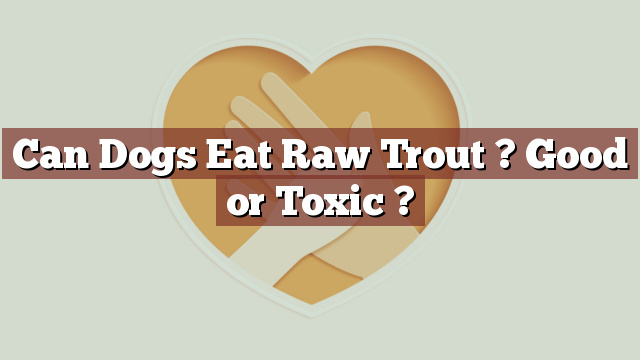Can Dogs Eat Raw Trout? Good or Toxic?
As pet owners, it is crucial for us to be aware of the foods that are safe for our furry friends to consume. One such food that often raises questions is raw trout. In this article, we will explore the nutritional value of raw trout, understand its safety and potential toxicity for dogs, discuss the risks and benefits associated with feeding it to them, and provide guidance on what to do if your dog consumes raw trout.
Nutritional Value of Raw Trout: Vitamins, Minerals, and Omega-3s
Raw trout is a fish known for its rich nutritional content. It is packed with essential vitamins, minerals, and omega-3 fatty acids. These nutrients are vital for optimal health and well-being in dogs. Raw trout contains significant amounts of vitamins such as vitamin D, vitamin B12, and vitamin B6. It also provides minerals like potassium, phosphorus, and selenium, which support various bodily functions. Furthermore, the omega-3 fatty acids found in raw trout promote a healthy coat and skin, reduce inflammation, and support brain function.
Can Dogs Eat Raw Trout? Understanding Safety and Toxicity
Can dogs eat raw trout? The answer is yes, dogs can safely consume raw trout. However, there are some important considerations to keep in mind. While raw trout itself is not toxic to dogs, it is crucial to ensure that the fish is fresh and sourced from a reputable supplier. Freshness is key to avoid potential bacterial contamination, which could lead to food poisoning or gastrointestinal issues in your canine companion.
Moreover, it is important to note that some dogs may have allergies or sensitivities to fish. If your dog has not consumed trout before, it is advisable to introduce it gradually and monitor for any adverse reactions such as vomiting, diarrhea, or itching.
Potential Risks or Benefits of Feeding Raw Trout to Dogs
Feeding raw trout to dogs can have various benefits. As mentioned earlier, its nutritional value provides dogs with essential vitamins, minerals, and omega-3 fatty acids. These nutrients contribute to a healthy immune system, strong bones, and a shiny coat. Additionally, the high protein content in raw trout supports muscle development and maintenance in dogs.
However, there are potential risks associated with feeding raw trout. As with any raw food, there is a risk of bacterial contamination, such as salmonella or E. coli. This risk can be minimized by sourcing high-quality, fresh trout and handling it properly. Additionally, bones in raw trout can pose a choking hazard or cause gastrointestinal blockages if swallowed without proper chewing. It is crucial to remove all bones before feeding raw trout to your dog.
What to Do if Your Dog Eats Raw Trout: First Aid and Monitoring
If your dog consumes raw trout, there are a few steps you can take to ensure their well-being. Firstly, check for any immediate signs of distress or allergic reactions. Watch for symptoms such as vomiting, diarrhea, excessive drooling, or difficulty breathing. If these symptoms persist or worsen, contact your veterinarian immediately.
Additionally, monitor your dog closely for the next 24 hours. Look for any changes in behavior, appetite, or bathroom habits. If your dog shows any signs of illness or discomfort, seek veterinary advice promptly.
Conclusion: Moderation and Veterinary Guidance for a Healthy Diet
In conclusion, dogs can safely consume raw trout as part of a balanced diet. It offers various nutritional benefits, including vitamins, minerals, and omega-3 fatty acids. However, it is important to ensure the trout is fresh, sourced from a reputable supplier, and that all bones are removed before feeding it to your dog. As with any new food, introduce it gradually and monitor your dog for any adverse reactions. If you have any concerns or questions about feeding raw trout to your dog, consult with your veterinarian for guidance tailored to your dog’s specific needs. Remember, moderation and veterinary guidance are key to maintaining a healthy and nutritious diet for your beloved canine companion.
Thank you for investing your time in exploring [page_title] on Can-Eat.org. Our goal is to provide readers like you with thorough and reliable information about various dietary topics. Each article, including [page_title], stems from diligent research and a passion for understanding the nuances of our food choices. We believe that knowledge is a vital step towards making informed and healthy decisions. However, while "[page_title]" sheds light on its specific topic, it's crucial to remember that everyone's body reacts differently to foods and dietary changes. What might be beneficial for one person could have different effects on another. Before you consider integrating suggestions or insights from "[page_title]" into your diet, it's always wise to consult with a nutritionist or healthcare professional. Their specialized knowledge ensures that you're making choices best suited to your individual health needs. As you navigate [page_title], be mindful of potential allergies, intolerances, or unique dietary requirements you may have. No singular article can capture the vast diversity of human health, and individualized guidance is invaluable. The content provided in [page_title] serves as a general guide. It is not, by any means, a substitute for personalized medical or nutritional advice. Your health should always be the top priority, and professional guidance is the best path forward. In your journey towards a balanced and nutritious lifestyle, we hope that [page_title] serves as a helpful stepping stone. Remember, informed decisions lead to healthier outcomes. Thank you for trusting Can-Eat.org. Continue exploring, learning, and prioritizing your health. Cheers to a well-informed and healthier future!

